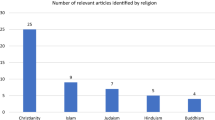Abstract
Raymond Chandler, the creator of legendary detective Philip Marlowe and the recipient of increasing literary admiration over the past 40 years, used numerous physicians as minor characters in his novels and short stories. The presence of physicians as minor characters in Chandler's work, though unnoticed by previous critics, is illustrative both of the writer's personal antipathy towards medical doctors and larger societal forces which left medical charlatans free to open “clinics.” Chandler's own chronic health problems and those of his wife Cissy may have contributed to the writer's negative attitude toward medicine and heath care, though little is known of Chandler's personal interactions with physicians prior to his death in 1959.
Similar content being viewed by others
REFERENCES
Auden, W. H. (1948). The guilty vicarage. In The dyer's hand and other essays (pp. 146–158). New York: Random House.
Bailey, J. E. (1996). Asklepios: Ancient hero of medical caring. Annals of Internal Medicine, 124, 257–263.
Chandler, R. (1953). The long goodbye. New York: Ballantine Books.
Chandler, R. (1972a). Killer in the rain. New York: Ballantine Books.
Chandler, R. (1972b). Bay city blues. In Killer in the rain (pp. 222–287). New York: Ballantine Books.
Chandler, R. (1972c). The man who liked dogs. In Killer in the rain (pp. 46–86). New York: Ballantine Books.
Chandler, R. (1976a). The high window. New York: Vintage Books.
Chandler, R. (1976b). Farewell my lovely. New York: Vintage Books.
Chandler, R. (1976c). The lady in the lake. New York: Vintage Books.
Chandler, R. (1995a). Stories and early novels, New York: The Library of America.
Chandler, R. (1995b). Later novels and other writings. New York: The Library of America.
Jacobs, L. R. (1993). The health of nations: Public opinion and the making of American and British health policy. Ithaca: Cornell University Press.
MacShane, F. (1986). The life of Raymond Chandler. Boston: G.K. Hall & Co.
MacShane, F. (Ed.) (1981). Selected letters of Raymond Chandler. New York: Columbia University Press.
Oates, J. C. (1995, Dec. 21). The simple art of murder. The New York Review of Books, 32–40.
Rabinowitz, P. J. (1995). Rats behind the wainscoting: Politics, convention, and Chandler's The big sleep. In J. K. Van Dover (Eds.), The critical response to Raymond Chandler (pp. 117–137). Westport: Greenwood Press.
Shaw, G. B. (1958). The doctor's dilemma. New York: Penguin Books.
Spender, N. (1977). His own long goodbye. In M. Gross (Ed.), The world of Raymond Chandler (pp. 127–158). London: Weidenfeld and Nicolson.
Starr, P. (1982). The social transformation of American medicine. New York: Basic Books.
Author information
Authors and Affiliations
Rights and permissions
About this article
Cite this article
Gollard, R.P. Physicians and Gumshoes: Prescription for Bad Medicine, or the Man Who Didn't Like Doctors. Journal of Medical Humanities 19, 25–38 (1998). https://doi.org/10.1023/A:1024983801221
Issue Date:
DOI: https://doi.org/10.1023/A:1024983801221



